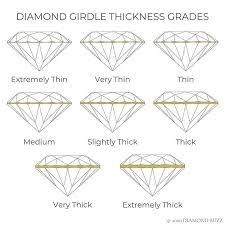
The girdle is the portion of the diamond that produces the outline when viewed from the top. The girdle divides the pavilion, or bottom, from the crown, or group of facets around the top, as viewed from the side. Most significantly, because the girdle is in contact with the setting, it may be knocked. As a result, diamond girdles must be long-lasting. Girdles were usually bruted, meaning two diamonds were ground round on top of each other. The outcome was a waxy, dreary look. Most bigger diamonds are now faceted with a high number of extremely tiny flat facets or polished smooth. A faceted girdle does not increase a diamond's grade, but if the stone is a fish-eye, a bruted girdle appears considerably worse.
In most situations, girdle thickness has little bearing on your diamond purchase. Any diamond grade, from "Very Thin" to "Very Thick," may be stunning and long-lasting. Avoid diamonds with “Extremely Thin” girdles, and carefully inspect diamonds with “Extremely Thick” girdles.
If the diamond girdle is "Extremely Thin," it might not be able to survive daily use. The prongs that keep the diamond in place might cause feathers if the girdle is too thin. Thin girdles that are exposed to the elements can also chip. Avoid any diamond with this girdle thickness grade if you have better options.
A girdle that is "Extremely Thick" isn't necessarily a reason for concern. Even if you find a diamond with excellent performance and a “Extremely Thick” girdle, it can still be used to create a beautiful diamond engagement ring. However, “Extremely Thick” girdles can frequently lead to poor diamond performance. Some girdles are so thick that they distort the shape of the diamond. As a result, light entering the diamond from the top does not return to your eye, but rather departs via the girdle or pavilion. The diamond just does not look as nice if the light does not return to your eye.
The hue of fancy colored diamonds determines their worth. Colored diamonds have broader girdles than white diamonds because their color is judged face-up rather than face-down like white diamonds. Although a well-cut diamond can have a thick girdle, “Extremely Thick” girdles are more prevalent in yellow diamonds, as they can considerably increase the diamond's price. However, this does not imply that they are a good investment.
Furthermore, a thicker girdle conceals weight. A diamond with a thicker girdle will seem smaller, rather than being the right size for its carat weight. When seen from the top down, a 1.2-ct diamond may appear to have the length and breadth of a one-carat diamond because the weight is hidden as depth by a "Extremely Thick" girdle. This means you're paying for extra weight you won't notice, and the extra weight will most likely degrade the diamond's performance.
Don't be alarmed if you notice a line across the side of your diamond approximately a third of the way down. It's most likely a reflection of a girdle. Light that enters via the girdle generally exits through the pavilion due to the way light travels through a diamond. This does not imply that the cut is of low quality. It's merely a result of the diamond's shape. Although many people mistake a girdle reflection for a fracture or a feather inclusion when they first encounter one, a girdle reflection isn't a clarity flaw. Reflections are more visible on bruted girdles and thicker girdles, although this does not imply poor cut quality.
Another crucial function of the diamond girdle is to protect the diamond. The girdle can be inscribed with a report number by gem laboratories, allowing you to link a laboratory report to the actual object. Laser inscriptions can also reveal if the diamond was created in a lab or if it has been treated for clarity or color.

